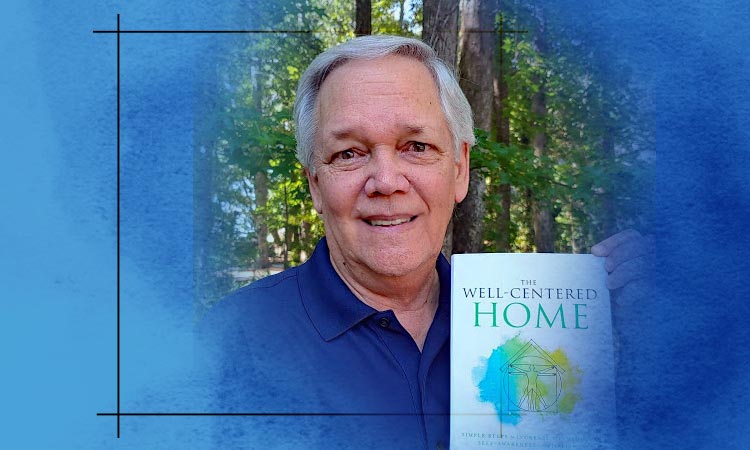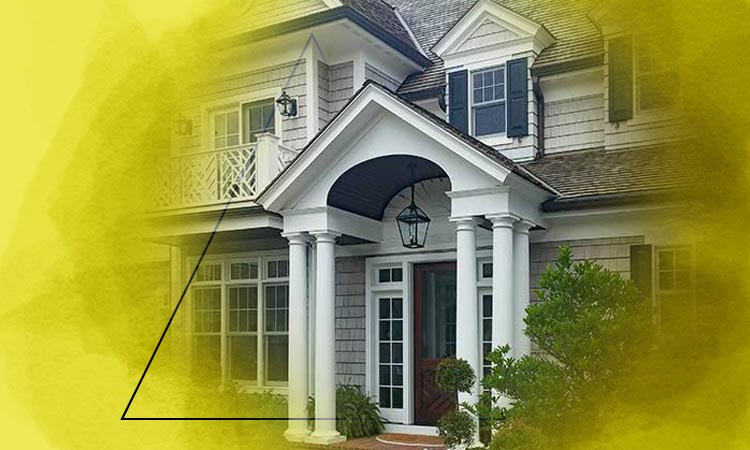Author Interview

The title, The Well-Centered Home; Simple Steps to Increase Mindfulness, Self-Awareness, and Happiness Where You Live, is intriguing. What does that title mean?
We live in a complicated, fast-moving world. It’s easy to suffer from mental overload and hyper-stimulation. Our psyche and emotions need a way to recover and be rejuvenated. To do that, some people practice yoga or meditation and set aside time to bring their minds into a calm, centered state. But you can design and arrange your home, the place where you spend the majority of your life, to be an external version of that state, one that easily moves you into a healthy frame of mind simply by occupying your home and interacting with the space. In the well-centered home, you bring the conditions of meditation into every moment.
What prompted you to write the book?
I’ve spent my career, almost fifty years, designing homes for all kinds of people with all kinds of lifestyles and during that time, the most gratifying complement I’ve gotten is when someone says my houses just feel right. It has little to do with the style or size of the house. It has everything to do with the house suiting the owners in a physical and psychological way. When that happens, the house becomes a home. It goes beyond being a mere building and becomes something else, something much more valuable and beneficial to those who live there. For years I have wondered why that catharsis happens. What transforms a house into a home? I understand it now and the theory in this book is my answer to that question.
Who is the audience – don’t you have to be wealthy to have a well-centered home?
Not at all. The audience is anyone who lives in any home. It doesn’t matter if that home is an efficiency apartment of a five-bedroom estate. The principles and benefits of a well-centered home are universal. In fact, smaller homes are often easier to center than large ones because creating an appropriate human scale in the home is a key factor in home-centering. Throughout the book, I offer suggestions for ways to improve the centering of your home at various levels of cost and difficulty. Many suggestions call for rearrangements of the furnishings, simplifying spaces, and removing or fixing things that disrupt the flow of energy in the home. Things like that do not require much or any money. They only require thought and action.
Why is the pandemic a great time to focus on this?
During this pandemic, our homes are essentially our entire life. Because we are all spending so much of our time in our homes, it’s critical that the energy in our home is focused in a positive way and works to increase our happiness. At this stressful time, we need our homes to help us emotionally and relieve our stress. Home-centering makes that happen. In our normal lives, we already spend the majority of our time in our homes. That’s why a well-centered is always so important. With the pandemic and social distancing, our homes have the greatest impact on our emotional well-being that they ever had. By going through the process of centering your home you can make sure that impact is highly positive. You are staying at home to safeguard your health. Now make that time also safeguard your emotional well-being. Plus, the benefits of a well-centered home don’t end when the pandemic ends. The good feelings will last long after the pandemic is over.
You mentioned your long career. What’s your background? What qualifies you to write this book?
I am a registered architect with a Masters Degree from the University of Virginia. I also have a Bachelor’s Degree in psychology. I’ve always been interested in the psychology of architecture. In other words, why do people respond to buildings, or what we architects call the built environment, the way we do. And how does the built environment affect our feelings, emotions, and our behavior? This is my second major book, my first was Designing Your Perfect House which was an Amazon #1 bestseller and is still available. That book examined how to design your house specifically for you. How to get it to fit you perfectly. The Well-Centered Home takes off from there and offers guidelines to help anyone improve the feel and energy of their homes to help them have a happier and more mindful life.
You said that a well-centered home can bring you many of the same benefits that practicing meditation can, but it happens in a passive way. How can a home do that?
You already experience this to some degree. After a difficult or busy day, don’t you feel a sense of calming when you get home? Home-centering is a way to amplify that feeling and those emotional benefits. We live in a universe that is teeming with energy. Some we see, such as light. Some we can’t see but we can control, such as radio waves and electricity. Other energy is invisible, but somehow we know is there. Emotions, karma, good or bad luck. It goes by various names. People have felt the impact of this unseen energy and tried to control and focus it for centuries upon centuries. By understanding yourself, removing things that disrupt energy, and by adding or altering things to promote positive energy, you can create a well-centered home that works to align and direct that energy for the benefit of you and your family, the people who live there.
Is this a new concept?
Yes, home-centering is a new concept. But the idea of working with the unseen energies all around us is not new. The ancient Chinese methods of Feng Shui and the Indian wisdom of Vastu are examples of methodologies devised to align a home with these energies to improve the lives and prosperity of those who live there. Those methodologies adjust the home based on specific orientation, a mapping system, and a standard set of rules. However, that same system applies to every home. A well-centered home is unique to each person or family. It does not dictate, but rather suggests. And more importantly, the suggestions are individualized to the home’s occupants. Who they are and what their personal inclinations and preferences are combined with universal principles to create a home that is tailored to them, specifically.
How can the process of home-centering be so customized if you don’t know the residents?
Because they know themselves. Home-centering does not require an outside consultant or adviser. The process starts with a simple Homebody Quiz. This is designed to help people understand their own preferences and what speaks to them on a psychological and emotional level. There are four basic homebody types, but nobody is 100% one homebody type or another. We all share aspects of all four. The quiz will help you recognize your primary homebody type and it will also help you see your secondary tendencies. This new understanding of themselves helps people make choices and decisions regarding their homes that are customized to them personally.
What are those four homebody types and how did you come up with them?
There are four homebody types, Astaire, Galileo, Plato, and Nightingale. I chose those names because these are well-known people who express the personality characteristics of each homebody type. An Astaire is an outgoing person who likes to interact with others and enjoys some excitement in their lives. A Galileo is an inquisitive person who takes a scientific look at life. A Plato is more introspective and is a person who wants to know the deeper meaning of things. And a Nightingale is a person who nurtures and comforts others and is sensitive to the feelings in life. Understanding your homebody type will give you insight into your tendencies and help you optimize the centering of your home for you specifically.
How do people know what to do with that new insight? How do they apply that to their homes?
In the book, I suggest many action items. I call these pebbles and pearls. Pebbles are things that irritate you, either on a conscious level, like a pebble in your shoe would, or on a subliminal level where you may have become desensitized to the irritant, but once it is gone you gain the positive benefit of removing the irritation. Think of a squeaking door hinge that you grew accustomed to but on a subliminal level is disrupting the flow of your emotional energy. After the hinge is oiled, you may not consciously notice the improvement every time you open the door, but your inner self will. And the positive energy in your home will no longer be negatively impacted.
I understand pebbles, but what are pearls?
Pearls are things you can do to add positive energy to your home. A pearl might be as simple as placing a mirror on a blank wall to simulate a window and create a sense that the room is more open to the outside to nature than it actually is. Or a pearl could be the addition of a screened porch to provide more of a physical connection with nature and to provide an in-between space that transitions from indoors to outdoors.
Adding a screened porch sounds like a major project. Are pearls expensive or difficult to add?
No. Many are no cost or low cost and require little effort. Pearls can be as simple as adding a few throw pillows with a fabric that is pleasant to the touch or rearranging the family room furniture to encourage group interaction. Adding that pearl would cost nothing other than a few minutes of your time. But others could involve more expense and effort. It depends on your resources and needs. There is no need to do everything that is suggested, of course. Small pearls can be very valuable.
That flexibility means home-centering can be useful for almost anyone. But there are some basic principles that are key to the process. Tell us about those.
There are two important foundational principles. First is anchoring. Being lost or adrift induces anxiety. Knowing where you are and feeling connected to a familiar place is calming. That’s what you want your home to be. I call this “anchoring” and it involves increasing your awareness of where you and your home are located physically and psychologically in your town, on earth, and even in the universe. This is important to synchronizing the center of your personal energy with the center of the energy in your home.
The second and most important principle of home-centering is “earth-grounding.” This is the creation of a visual and perceptual connection between your home and the earth. It is about linking to nature to give your home a firm foundation and a healthful relationship with the planet we live on. A connection to nature promotes good physical and emotional health. Linking your home visually and physically to the earth will provide much the same sense of connection and stability that the principle of grounding does in meditation practice.
Does home-centering replace meditation?
No. I would suggest that one supplements the other. They work toward the same results. Both help relieve stress and anxiety by promoting calmness, well-being, and emotional peacefulness. Meditation involves an allocation of time and practice. Often our lives are too busy to allow as much time for meditation as we would like. Home-centering provides a benefit passively. By simply living in your well-centered home you can gain many of the same benefits you would get from meditation. Your home can rejuvenate your state of mind and help you leave the stresses of the day behind. If you also routinely meditate, the benefits of both are enhanced.
What will be the end result of creating the well-centered home?
Your home will become your peaceful retreat and safe haven from an often chaotic world. It will act like a therapy machine to refocus your energy, rejuvenate your psyche, and draw your personal energy toward your center. Just as you recharge your phone at the end of the day, your home becomes the recharging station for you. Your well-centered home will bring you the good fortune and wealth of being peacefully mindful, contentedly self-aware, and certainly happier. I would suggest that is the true definition of a wonderful life.



